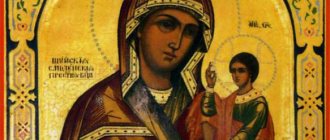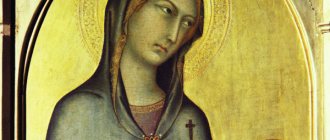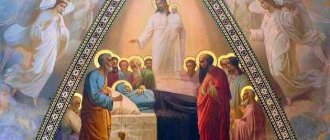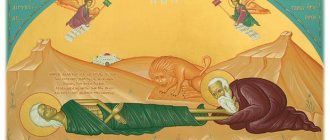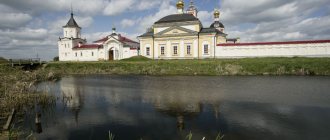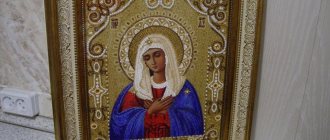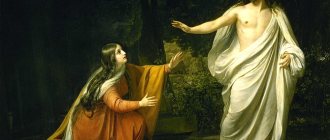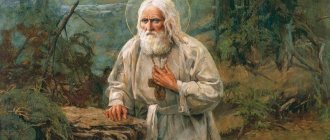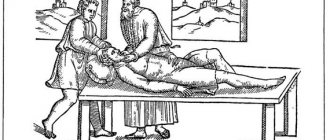| Mother Maria (Skobtsova) |
Maria (Skobtsova)
(1891 - 1945), nun, poet and author of religious articles, martyr Memory of July 20 (Const.)
In the world, Skobtsova Elizaveta Yuryevna, nee Pilenko, in her first marriage - Kuzmina-Karavaeva, was born on December 8, 1891 in Riga in the family of a Crimean landowner. I spent my childhood and adolescence near Anapa. There, her father, a talented amateur agronomist and later director of the Nikitsky Botanical Garden in Crimea, had a small estate with a vineyard. After the death of her father in 1906, the family finally moved to St. Petersburg, where Lisa entered a private gymnasium. At the age of 15, she became interested in literature and art, attending literary evenings, at one of which Blok spoke. Thus began a friendship. She was 15 years old, and the famous poet was 25. Subsequently, they corresponded for many years.
After graduating from high school, she entered the philosophy department of the Bestuzhev Courses [1].
At the age of 18, she married a lawyer, a member of the Socialist Revolutionary Party D.V. Kuzmin-Karavaev, a close friend of many writers, who later became a Catholic priest. During their short marriage, Elizaveta Yuryevna delved into religious searches, and the spirit of Christianity became more and more established in her.
She wrote poetry and participated in the literary and artistic life of St. Petersburg, visited V. Ivanov’s “tower” and A. Blok’s circle. In 1912 she published her first collection of poems.
She separates from her husband and in 1913 leaves with her daughter Gayana for her native Anapa, where she settles on the family estate. Here she experiences the beginning of the revolution and meets her future husband, Daniil Skobtsov.
Before the revolution, she was a member of the Socialist Revolutionary Party and sympathized with the revolutionary events. In 1918 [2] she was the mayor of Anapa. In Moscow, she participated on the side of the Socialist Revolutionaries in actions against the Bolsheviks.
In March 1919, she was arrested in the South by white troops and sentenced to two weeks in prison.
She emigrated through Tiflis to Constantinople with two children and D.E. Skobtsov, where she married him. In Istanbul, she gives birth to another daughter, Nastya, who died at the age of two.
In 1920 [3] she moved to Serbia.
| Prmts. Maria (Skobtsova). Icon |
In 1923, she settled in Paris with her family.
Active member of the Russian Student Christian Movement (RSCM), participant in its first congresses. In 1930, she was elected local secretary in France for work in the French province.
Since the late 20s in Paris, she began to help everyone who needed support and help. Elizaveta Yuryevna began to strive for monasticism as selfless service to the Lord and people. She was under the jurisdiction of Metropolitan Evlogy (Georgievsky).
On March 7, 1932, she received a church divorce.
In March 1932, she was tonsured a monk by Metropolitan Evlogii. When she was tonsured, she received a name in honor of Saint Mary of Egypt.
In 1932 she founded a hostel for single women in Paris (9, villa de Saxe). Two years later the hostel moved to 77 Lourmel Street.
In 1933, she participated in the RSHD congress in Estonia. She was elected secretary of the Central Secretariat of the RSHD for missionary and social work.
In 1935, M. Maria’s daughter Gayana left for the USSR and two years later died in Moscow from dysentery.
On September 27, 1935, together with G.P. Fedotov, I.I. Fondaminsky and F.T. Pyanov, she founded the “Orthodox Cause”, a charitable and cultural-educational organization to help Russian emigrants.
In 1935, together with F. T. Pyanov and priest Mikhail Chertkov, she founded a “House of Rest” for convalescent tuberculosis patients in the town of Noisy-le-Grand, and in 1936 she opened, also with the help of F. T. Pyanov, a cheap hostel in a mansion No. 43 on the street. François Gerard (in the 16th arrondissement of Paris), which became a branch of the central hostel on the street. Lourmel. She founded a canteen for the unemployed in Paris.
Then, in 1936, at the hostel on the street. Lourmel was organized a church in the name of the Intercession of the Blessed Virgin Mary and courses for psalm-readers, and in the winter of 1936 - 1937. - missionary courses.
She visited mentally ill people in hospitals.
After the outbreak of World War II, she took part in the activities of the French Resistance. With the beginning of the occupation of Paris, the house that she founded on the street. Lourmel, 77, becomes one of the headquarters of the Resistance, the center of anti-fascist activity in Paris. Soviet soldiers who escaped from captivity lived in it, parcels and money were sent, and escapes were arranged. The soul of the Lurmel committee was Mother Maria.
| Venerable Martyr Nun Maria (Skobtsova) |
On February 9 or 10, 1943, together with Father Dmitry Klepinin, she was arrested by the Nazis and kept in a concentration camp at Fort Romanville, then in the Compiegne camp, and from there she was taken to Germany to Ravensbrück.
O. Dimitri and her son Yuri Skobtsov were sent to Buchenwald. She was executed on March 31, 1945 in the Ravensbrück concentration camp in a gas chamber. There are several versions of her death. According to one version, Mother Maria went to the gas chamber instead of one of the women selected by the Nazis. According to another, she suffered from dysentery and was hidden for a long time, but was finally discovered at the end of March. She could not stand on her feet, she was so weak. The next day she was sent to the gas chamber.
In 1985, Mother Mary was posthumously awarded the title “ Righteous Among the Nations”
» [4].
In 1992, in the village of Yurovka near Anapa, at the grave of the ancestors of Mother Maria, a symbolic burial of ashes from the Ravensbrück concentration camp took place.
On February 9, 2003, a memorial plaque was installed on the site of Mother Maria’s former dormitory - the Orthodox Cause house [5].
On January 16, 2004, the Holy Synod of the Orthodox Church of Constantinople canonized Mother Mary.
She was a poet, artist, philosopher, and an excellent embroiderer. But, having taken monastic vows, she devoted all the talent of her soul, all her strength and love to helping her neighbors and the disadvantaged.
According to Nikolai Berdyaev: “ In the personality of Mother Mary there were traits that are so captivating in Russian holy women - an appeal to the world, a thirst to alleviate suffering, sacrifice, fearlessness
.»
influence
In February 1908, she met A. Blok. Attended meetings “at the tower” of Vyach. Ivanova, meetings of the “Workshop of Poets”, religious and philosophical meetings, communicated with Nikolai Gumilyov, Anna Akhmatova, Osip Mandelstam, Mikhail Lozinsky.
Spiritual daughter Fr. Sergius Bulgakov. In exile she was close to the circle of Nikolai Berdyaev and Georgy Fedotov.
- Nikolai Berdyaev and mother Maria (1930).
- Seminar about. Sergius Bulgakov on asceticism and culture (1933).
- Metropolitan Evlogy (Georgievsky), John Mott and mother Maria (Skobtsova).
- Congress of the RSHD, 1937.
- Congress of the "Orthodox Cause". France, Boissy-l'Ayerie, 1937.
- Mother Maria (Skobtsova), Dorothy Day, Fr. Leo (Gillet), Mother Teresa, Fr. Alexander Shmeman. "New Skete" (Cambridge, New York).
The modernist bestseller by Fr. is dedicated to Mother Mary. Sergius Gakkel “One of Great Price. The life of Mother Marie Skobtsova, Martyr of Ravensbruk" ("Mother Mary") (1965).
In Alexei Tolstoy’s novel “Walking Through Torment,” the St. Petersburg period of her life served as the prototype for the character “Elizaveta Kievna.” The 1982 film “Mother Maria” with Lyudmila Kasatkina in the title role is dedicated to the fate of Mother Maria.
In France there is the “Society of Mother Mary”, in St. Petersburg - the “Union of Friends of Mother Mary”, in Riga - the “Society of Friends of Mother Mary” (co-chairman Elena Pavlova[1]). In 1999, the Orthodox Cause society named after. mother Maria (chairman A. A. Solovyov). There is an exhibition about her in the folk museum of the village. Yurovka, where the estate of the Pilenko family was. A memorial hall dedicated to her has been created in the Anapa Archaeological Museum. A memorial sign has been installed on the Anapa embankment. The name of Mother Maria is immortalized on memorial plaques in Paris and Riga, St. Petersburg and Ravensbrück. In Jerusalem, at the Yad Vashem Museum on the Alley of the Righteous Among the Nations, an olive tree was planted in her honor, and a memorial plaque was installed in the Alexander Metochion[2].
On March 31, 2021, the opening ceremony of the street named after Maria (Skobtsova) took place in Paris. The new street adjoins Rue Lourmel in the XV arrondissement, where the Orthodox Cause association was located[3].
Ksenia Krivosheina, who has written several books and many articles about her, is popularizing the works and legacy of Maria (Skobtsova). She also created the website www.mere-marie.com.
estimates
What representatives of the Parisian school of theology were often reproached for: Bulgakov, Berdyaev, Zenkovsky, Mother Maria (Skobtsova) - “cigarette theology.” They could talk about God while smoking a cigarette. This is certainly an indicator of sensitivity, but what they say when smoking a cigarette is important. If they say something good, let's listen.
When Metropolitan Anthony first saw Mother Maria, he was shocked because he saw her, a Russian nun, in a Parisian cafe, drinking beer with someone. It seemed to him that this was impossible! But Metropolitan Anthony came to understand that she served God well[4].
- ep. Seraphim (Sigrist)
Mother Mary is truly an unusual saint. She smoked and led a bohemian lifestyle before her tonsure, and even after her tonsure she did not look like a quiet nun, busy only with prayer and fasting. Her monasticism was not a death to the world, but something quite the opposite—that shocking invasion into the world that clearly testified to the vitality of Christianity. She was able to accomplish a lot in her life, for which she is truly worthy of church veneration. Her life creativity surpasses poetic creativity, and there is novelty in this too[5].
- O. Georgy Mitrofanov
Orthodox Life
March 31, 1945. Nazi concentration camp for women Ravensbrück. During the next “selection” of prisoners for the gas chambers, one of the unfortunate people fell into hysterics from fear.
From the crowd of women who were luckier that day and were not chosen for the “death machine”, a prisoner came out and tried to support the poor girl: “Don’t be afraid, the last word is still not death, but life.” “How can you prove it?” – asked the desperate condemned woman. “And I’ll go with you,” said the exhausted woman, smiling tiredly and kindly at the corners of her lips. This woman is Mother Maria Skobtsova, an Orthodox nun in the world, imprisoned in a camp for her active participation in the French Resistance.
This story has many different versions (among them, for example, the story that Mother Maria (1891–1945) selflessly exchanged a dress with an ill-fated number with a condemned girl, etc.). We don't know the details.
We can’t even say for sure whether this story took place in real life. We are content with only conflicting testimonies from survivors. However, the story of this impetuous, strange, “fiery” woman almost certainly convinces us that this was exactly how the end of her journey should have been.
The modern Belarusian poetess Liza Strotseva has a poem:
Straitjacket - for the heart wide open
do not dress, gather all the wounded guys:
and go out into the city and bravely say what you want to call
flood the whole earth with flowers, my eyes, before you are tired and hurry to be
and every step is careless like an exam
Take it like coloring a notebook in a box and getting a two.
These lines are like the quintessence of the life of Mother Maria, whom many did not understand during her lifetime: she may even have irritated some with her straightforwardness, activity and indifference; others considered her a holy fool precisely because of her “madness” of heart, love, which was often impossible to explain rationally, illogical, even absurd. Today they make films about her life (Mother Maria, 1982, directed by S. Kolosov), and write books. Her journalism is analyzed at theological conferences, and she is remembered as the first woman in the Russian Empire to take a course in theology (in 1913 at the St. Petersburg Theological Academy with the blessing of the local metropolitan). Literary scholars write studies and analyze her poetry. And although on January 16, 2004 she was canonized by the Patriarchate of Constantinople, even now disputes about this in church circles do not subside: Mother Maria was too wonderful...
***
1919 “Cursed days”, when the old world collapsed, and the new one tore out the intelligentsia, clergy, etc., throwing them overboard of life. Elizaveta Yuryevna Skobtsova (née Pilenko), hereditary noblewoman, daughter of the director of the Yalta Botanical Garden, together with her second White Guard husband, chairman of the military district court of the Kuban region, Cossack Daniil Ermolaevich Skobtsov, mother, daughter Gayana, emigrates from Russia through Poti, Tiflis, Batum . First to Istanbul, then to Yugoslavia, and later to Paris. During her wanderings, Elizaveta Yuryevna gave birth to a son, Yuri, and a daughter, Nastya.
Skobtsova considered emigration to be perhaps her main mistake. And even in the last year of her life, at the height of World War II, being an active participant in the Resistance, she planned to return to her homeland. And only because of the arrest these plans were not destined to come true.
The emigration met the large Skobtsov family, like most emigrants at that time, hungry and cold.
According to the recollections of the poet and singer A. N. Vertinsky, who lived far from his homeland for a quarter of a century, it was almost impossible for men with a “Nansen passport” to find work (it was easier for women) - a lucky few were able to be seen peeling potatoes, knives or washing plates in restaurants. Moreover, it was not uncommon for generals and colonels to actually work for a plate of borscht. Vertinsky recalled how in the Hermitage restaurant a former governor worked as a cook in the kitchen, and in the Black Rose cabaret a former senator worked in the dressing room. I also remember the emigrant childhood of Rev. Alexander Shmeman: he later told how he and his brother, the senator’s grandchildren, skipped physical education at school, not having anything to buy a sports uniform for, hid holes in their clothes from mocking classmates, slept at the bottom of an old closet due to the lack of a bed, and their parents had to be content with odd jobs (they got jobs as nurses, dishwashers, at gas stations, etc.), and it was mainly the mother who managed to find work.
Elizaveta Yuryevna Skobtsova with children in exile
The Skobtsovs also tasted the “delights” of emigrant life. The burden of responsibility for financially supporting the family fell mainly on the shoulders of Elizaveta Yuryevna (although her husband worked part-time as a taxi driver). Just yesterday she was a regular at intellectual bohemian gatherings on Wednesdays at Vyacheslav Ivanov’s “Tower” (in the poet’s St. Petersburg apartment in house No. 25 (35) on Tavricheskaya Street), where the entire intellectual elite of Russia of that time visited at various times since 1905: the Merezhkovskys, Alexander Blok, Andrey Bely, Fyodor Sologub, Vsevolod Meyerhold, Maximilian Voloshin, Anna Akhmatova, Valery Bryusov and many others.
And now she, a recognized poetess in Russia, according to the recollections of her niece Elena Borisovna Delaunay, is forced here in Paris, in order to feed her loved ones, not to shy away from any work. Although Skobtsova wrote “drawing” in the “profession” line in the emigrant questionnaire (she really spent her entire life painting the most wonderful icons, making wall paintings, often without even a preliminary sketch). Here she had to master all sorts of professions. Don't sleep for days. Constantly submit advertisements in the Russian newspaper “Last News” like: “I clean, wash, disinfect walls, mattresses, floors, remove cockroaches and other parasites.” Elizaveta Yuryevna earned money by sewing, painting fabrics, and making dolls, which forever ruined her eyesight.
***
But that wasn't the worst thing. The most painful thing for any parent is to outlive their children. First, three-year-old Nastenka dies suddenly from meningitis. Then, on the advice of A. Tolstoy, daughter Gayana returned to Russia (amazingly, this was the only case of lethal typhus in Moscow in 1936). In the Buchenwald concentration camp, her son Yuri will die in a gas chamber (or from exhaustion?) in 1945, but Skobtsova will never know about this loss, since she herself will be imprisoned within the concentration camp walls. Coming to terms with the loss of her beloved children was not easy for the rebellious Elizaveta Yuryevna, a former Socialist-Revolutionary - how much she cried out to God, asking “why?” It is no coincidence that the image of Job the Long-Suffering, who also for a long time could not accept and understand the Providence of the Almighty, was so important for her in her poetry.
After the death of Nastenka, an estrangement occurred between the Skobtsov spouses, and by mutual consent they divorced (although Elizaveta Yuryevna maintained friendship with her husband until the end of her life and even continued to write to him from the concentration camp). The inconsolable mother tried to express her pain from the loss of her child in poems, which she stopped writing for a while while in exile. However, there was a sense of need and need for a radical change in life, which had matured in her long before the tragic loss. In March 1932, Skobtsova took monastic vows with the name Maria in honor of St. Mary of Egypt. Metropolitan Evlogii Georgievsky, blessing Mother Mary for monasticism, drawing an analogy with the desert dweller Mary of Egypt, said to her: “I am sending you to the desert of human hearts.” Mother Maria said about monastic clothing that this is the first clothing in life that is pleasant, your own, comfortable, that you don’t notice. Fr. Skobtsova, who knew him well. Boris Stark wrote: “She was a nun to the core after a rather checkered life. For her, the cassock was leather, not a camouflage coat. For Mother Mary, love for God and love for people were inseparable.”
Second from left is Mother Maria
Among her outstanding friends (confessor Fr. S. Bulgakov, G.V. Fedotov, K.V. Mochulsky, I.I. Fondaminsky, L.A. Zander and others) many did not accept her tonsure and did not understand (for example, N. A. Berdyaev). They did not understand it even in the monastic environment. Mother Maria soon realized that it was precisely among the “desert of human hearts” that her monastic service should take place - the usual cenobitic monasticism, after a short asceticism in the Estonian Pukhtitsa Monastery, trips to Finland and Valaam, turned out to be alien to nature. “I want to create a new form of monasticism, a new type of community, half-monastery - half-brotherhood. We, thrown out by emigration, are different, we hang between heaven and earth. But at the same time, our church has never been so free. Freedom is so great that your head is spinning. Our task is to show that a free church is capable of working miracles.”
Her path of monasticism in the world and serving “all wounded children” began. She could more often be found caring about the needs of the disabled and single mothers than at the Liturgy. Mother Maria herself said with irony about herself that if they had opened her skull, they would have found nothing there except calculations, combinations and unpaid bills. This was not clear and unacceptable for many of her contemporaries, and even now it causes mixed reactions. A strange Russian emigrant nun could be seen in a Marseilles brothel, trying to get out and save several drug addicts. Or preaching to miners in the south of France, who told her with mockery and contempt: “You would rather wash our floors and clean up all the dirt than read reports.” After this caustic remark, the nun, without hesitation, to the surprise of the amazed workers, began to diligently wash the floors. Ashamed of their behavior, the miners brought their clothes and food to the smeared and wet nun, sat down next to her on the floor and began to listen to her sermon in a completely different way... Mother Maria was known not only as a poetess, but also as an active participant in the RSHD, a traveling missionary.
Skobtsova organized a hostel for single women, a rehabilitation center for tuberculosis patients, missionary courses, etc. In 1935, together with Fr. Dimitri Klepilin organized the charitable, cultural and educational movement “Orthodox Cause”. Mother Maria was often seen at the Parisian wholesale market “The Belly of Paris,” buying cheap for her charges, or even simply collecting donations for her almshouse from French merchants who respected her. It was difficult to imagine that this tall, myopic woman, dressed in rags and men’s worn-out shoes or boots, with a huge heavy bag over her shoulders, was the same Elizaveta Pilenko, whom Nikolai Gumilyov (1908–1909) once unsuccessfully tried to court, that the most 15-year-old enthusiastic girl, unrequitedly in love with 26-year-old Alexander Blok, to whom the poet dedicated his famous poem “When you stand in my way, so alive, so beautiful.”
Although she always cared little about appearance (too petty an occupation for her broad soul), Blok also wrote to her: “You despise your beauty.” And yet she was beautiful, beautiful in a different kind of beauty.
As people who knew her remember, when she entered, it was as if she filled the entire space of the room. T.P. Milyutina writes: “...Very disorderly, completely oblivious to her clothes, very short-sighted. But those myopic eyes sparkled so intelligently behind the glasses, her ruddy face smiled, and her speeches were so assertive, there was such conviction in her statements, she was so passionately obsessed with some idea or plan that it was impossible not to believe in her rightness, into the absolute necessity of what was now burning so much, burning her soul so much. I have never heard her talk about anything with indifference. If a topic didn’t resonate with her, she simply didn’t enter into the conversation.”
Skobtsova amazed everyone with her courage and adventurism - to organize such risky, costly projects without actually having a penny to her name! For example, to maintain a boarding house-canteen for 25 starving people on the Rue de Lourmel for 20,000 francs a year (and before that for 100 on the Rue Sachs)! To such perplexed remarks, Mother Maria replied: “You think I’m fearless. No, in fact, I know that what is necessary will be.” And everything was truly found miraculously. The nun saw herself exclusively as an instrument in the hands of God.
Mother Maria, M. Courtin and mother Evdokia Meshcheryakova, 1936
Mother Maria knew how to maintain amazing patience and love for people who often responded to her with ingratitude and bitterness towards her kindness. Instead of saying “thank you,” the wards from Lourmel Street often robbed her and her loved ones. For example, in Mochulsky’s diaries there is an entry from 1934: “Mother Maria receives for free one morphine addict, who the next day stole 25 francs from Guyana. At dinner, Mother Maria threw this money under the sofa and said: “You see how imprudent it is to blame others without studying the matter thoroughly. The money fell behind the sofa. The unfortunate woman burst into tears."
Mother Mary said: “...The path to God passes through the love of man for man... At the Last Judgment they will not ask me whether I have performed enough ascetic practices and how many petitions and genuflections I have made. They will ask me if I fed and clothed the hungry, if I visited the sick and prisoners.” At the same time, she lived extremely ascetically and selflessly. In the boarding house, instead of a room, I allocated for myself a small closet under the stairs without heating. Traveled on a mission without suitcases, even without a change of clothes. She worked constantly herself. The already mentioned Mochulsky recalled: “He knows how to do everything: he does carpentry and carpentry; she crochets, paints icons, washes floors, types, and cooks dinner. She knows how to stuff mattresses, milk cows, and weed a garden. She enjoys physical labor and teaching those who cannot do anything with their hands. Another trait: she ignores the laws of nature, not feeling the cold, she can spend entire nights without sleep, she rejects fatigue and illness, loves danger, fear is unknown to her, and she hates comfort: spiritual or material. “Especially spiritual comfort,” she says.”
***
The Second World War began. In 1940, Paris was occupied, but Mother Maria and the “Orthodox Cause” not only did not suspend their activities, but, on the contrary, launched an even broader one. Skobtsova became an active participant in the Resistance, although any form of conspiracy, etc., was alien to her. Mother Maria clearly expressed her hostility towards the Nazis, which is why her behavior seemed provocative and unreasonable to many. I perceived caution as indifference, and I always considered lukewarmness to be the most terrible vice (in faith, relationships, etc.). In her closet under the stairs she installed a radio, on which she listened to the latest reports from the front of the Sovinformburo. She predicted victory in the war for the USSR, often openly in conversations with the French. And only the amazing Providence of God can explain the fact that Maria’s mother, with all her daring behavior, managed to hide “under the nose” of the Nazis for several years in a house on the street. Lourmel of Jews, disgraced French, Russians, etc. It was possible, together with the Red Cross, to establish a constant delivery of parcels to prisoners in concentration camps. Periodically saving lives, at the risk of their own, were Jews who, with the help of cunning plans, managed to be “pulled out” from concentration camps and transported abroad (for example, once my mother managed to bribe a garbage man in a concentration camp and hide three Jewish children in a pile of garbage being removed).
But still, the Nazis noticed the suspicious, active nun. First, her son-reader Yuri was arrested and sent to a concentration camp after a search was carried out in the house of the “Orthodox Cause”. Mother Maria, who miraculously was not found during the search, came to the Gestapo voluntarily herself, hoping to save her son. But even when she ended up in a concentration camp, she amazed those around her with her unbreakable will and inner fire. A typical episode: Mother Maria, an elderly woman, was attacked by a matron because she spoke to a neighbor during roll call. “Mother, as if not noticing, calmly finished the ... sentence she had begun. The enraged SS woman pounced on her and rained blows on her face with a belt, but she didn’t even bother to look.” And in captivity, mother, physically exhausted, continued to embroider icons, console her fellow prisoners, conduct catechetical conversations with them, read and interpret the Gospel, shared her already meager rations (although, according to the recollections of the prisoners, in the last days she was so exhausted that I could barely get out of bed). She found the strength to send soothing letters to her loved ones from the concentration camp, in which she wrote that “it’s good here”, “here we relax and we have a lot of free time”, etc. Before her death, Mother Maria began to embroider an amazing icon: the Mother of God holding the crucifix of her little Son -Baby. Skobtsova felt that if she completed the work, she would remain alive. Did not make it.
Despite all the mental and physical fatigue that mother spoke about at the end of her life, the inner fire did not go out in her until the last. “Either Christianity is a flame, or it does not exist at all... Christianity, like red-hot steel, pierces the heart and incinerates it. And then the person screams: “My heart is ready, ready!” And this is all Christianity, said Mother Maria. And these words contained all of Mother Maria Skobtsova herself.
Anna Golubitskaya
canonization
On November 13, 1991, in a speech before the rabbis, Patriarch Alexy mentioned Mother Maria (Skobtsova):
During World War II and the Nazi occupation, the clergy and believers of our Church risked their lives to shelter Jews. Classic examples of this are Mother Maria (Skobtsova), priests Dmitry Klepinin and Alexei Glagolev, and many others, about whose exploits, about their sacrificial service to the salvation of their Jewish brothers and sisters, we should all know[6].
In August 1993, at an ecumenical congress in Pomerol, organized by the Protestant women's community, a petition was drawn up and sent to Patriarch Alexy II of Moscow for the glorification of Mary (Skobtsova) and her companions, signed by Orthodox, Protestant and Catholic theologians[7].
In 2000, Met. Anthony (Bloom) turned to Metropolitan. Juvenaly Krutitsky and Kolomensky, as the Chairman of the canonization commission, to consider the issue of glorifying Mother Mary[8].
On January 16, 2004, she was canonized by the Patriarchate of Constantinople as a venerable martyr[9].
During the solemn rite of glorification of the newly canonized saints on May 1-2, 2004, in the Alexander Nevsky Cathedral in Paris, Christians of different denominations participated in the services. The Archbishop of Paris, Cardinal Jean-Marie Lustige, said Catholics would also honor these martyrs as saints and patrons of France.
During the Civil War, Elizaveta Yurievna defended the city
In the conditions of the Civil War and the change of power, Elizaveta Yuryevna was constantly looking for ways out of difficult situations.
Under the Reds, she defended the city and saved cultural values. When the city was captured by the White Guards, she was arrested, accused of conspiring with the Reds. She faced the death penalty.
But thanks to competent defense in court, she was arrested for only 2 weeks. The outcome of events was largely influenced by Daniil Ermolaevich Skobtsov, a prominent figure in the Kuban Cossack movement. After the trial, Elizaveta Yuryevna became his wife.
Daniil Ermolaevich Skobtsov. Husband of Maria Skobtsova. A prominent figure in the Kuban Cossack movement. Thanks to his connections and influence, Maria Skobtsova was released from arrest and not subjected to the death penalty
biography
On February 19, 1910, Elizaveta Pilenko married assistant attorney Dmitry Kuzmin-Karavaev, a former Bolshevik and close friend of many St. Petersburg writers. In the spring of 1913, she left her husband (the divorce was officially filed only at the end of 1916) and left St. Petersburg for Anapa.
In the summer of 1919, Kuzmina-Karavaeva married D. E. Skobtsov, a Kuban Cossack leader who was for some time the chairman of the Kuban Regional Rada. In the spring of 1920, after the defeat of the White movement in Kuban, Elizaveta Skobtsova with her mother S. B. Pilenko and daughter Gayana were evacuated to Georgia, where Elizaveta Yuryevna had a son, Yuri, then the entire Skobtsov family emigrated to Constantinople, lived for some time in Serbia, and in January 1924 she moved to Paris.
During the Nazi occupation of Paris, the hostel of the nun Maria on the Rue de Lourmel became one of the headquarters of the Resistance. In June 1942, when the Nazis carried out mass arrests of Jews in Paris and herded them to the winter velodrome for subsequent transport to Auschwitz, nun Maria managed to secretly remove four Jewish children from there in garbage containers. Houses on Lourmel and Noisy-le-Grand became shelters for Jews and prisoners of war, M. Maria and Fr. Dimitry Klepinin also issued fictitious baptismal certificates to Jews.
On February 9, 1943, the Gestapo arrested Maria (Skobtsova), who was first kept in the prison of Fort Romainville and then sent to the Ravensbrück concentration camp. Nun Maria was executed in the Ravensbrück gas chamber on March 31, 1945, a week before the liberation of the camp by the Red Army.
On May 7, 1985, by decree of the Presidium of the Supreme Soviet of the USSR, she was awarded the Order of the Patriotic War, II degree (posthumously)[10].
Maria Skobtsova spent her childhood in Anapa and Crimea
Lisa Pilenko was born in 1891 in Prague. Her father, Yuri Dmitrievich Pilenko, was a lawyer, and her mother, Sofia Borisovna, came from the famous Dmitriev-Mamonov family.
When Lisa was 4 years old, the family moved to Anapa. After the death of Lisa's grandfather, her father inherited the estate and vineyards.
December 20, 1891
Maria Skobtseva's birthday
With the help of her parents and the intelligentsia of Anapa, young Lisa received her primary education at home. From early childhood, she showed great talent for drawing and literature.
Her father devoted a lot of time to raising and teaching children. She loved her father very much, he was her first friend.
In the house of the Pilenko family there was always an atmosphere of friendliness, openness, and goodwill. This greatly influenced the future fate of little Lisa, and left a deep mark on her upbringing and spiritual growth.
Liza Pilenko, 1903. I spent my childhood in the south, in Anapa and Crimea. She grew up in an atmosphere of love and mutual respect. This greatly affected her mental and spiritual growth.
In the spring of 1905, her father was appointed director of the Nikitsky Botanical Garden.
The family moves to Crimea. And then, in 1906, Lisa’s father was transferred to St. Petersburg to the Department of Agriculture.
He brings his wife and children to St. Petersburg, and he himself returns to Anapa and suddenly dies.
1906
this year Maria’s family is moving to St. Petersburg
The death of her father greatly shocked Lisa and became a real blow of fate.
Even then, a protest against death and injustice arose in her soul. More and more often she began to think about God.
ideology
Kuzmina-Karavaeva greeted the February Revolution with enthusiasm and already in March 1917 joined the Socialist Revolutionary Party. She spent most of 1917 in Anapa, and in February 1918 she was elected mayor. When, after a short period of dual power, the Bolsheviks completely took power in the city, Kuzmina-Karavaeva took the post of Commissioner for Health and Public Education. In May 1918, she participated in the congress of the Right Socialist Revolutionary Party in Moscow and carried out underground anti-Bolshevik work; in the fall she returned to Anapa, where she was arrested by Denikin’s counterintelligence - she faced the death penalty for “commissarism” and participation in the nationalization of private property. On March 15, 1919, her case was considered by the regional military district court in Yekaterinodar, and only thanks to a skillfully organized defense, the defendant received only two weeks of arrest.
In 1913 - divorce, birth of a daughter
Lisa leaves all literary collections and continues her journey in search of faith. She attends theological courses at the Theological Academy. Successfully passes the exam. She was the first woman to be blessed with this teaching.
In 1913, Elizaveta Yuryevna left her husband and returned to her family estate in Anapa.
In the same year, her daughter Gayana is born. During these years, Elizabeth embarked on a path of mental discord and crossroads. She thinks more and more about God, the meaning of life.
organizations
Secretary of the Religious and Philosophical Academy (1920s), made reports at its meetings.
Since 1927, she became an active figure in the Russian Student Christian Movement (RSCM), as a traveling secretary, she traveled around France, visiting Russian emigrant communities, and gave lectures and reports. Participant in the RSHD congress in Estonia (1933).
In 1932, with the blessing of her spiritual father, Archpriest Sergius Bulgakova, she began her pseudo-monastic service in the world.
She organized a hostel for single women in Paris, a rest home for convalescent tuberculosis patients in Noisy-le-Grand near Paris, painted house churches, embroidered icons and shrouds for them. At the hostel, the Church of the Intercession of the Blessed Virgin Mary and courses for psalm-readers were established, and from the winter of 1936-1937 - missionary courses. On September 27, 1935, on the initiative of nun Maria, the charitable and cultural-educational society “Orthodox Cause” was created, which included Nikolai Berdyaev, Sergei Bulgakov, Georgy Fedotov, Konstantin Mochulsky.
She was a member of the literary association “Circle” (1935-1939).
Death of father, move and first marriage
After the death of her father, Sofia Borisovna and her children finally moved to St. Petersburg. Lisa enters the L.S. Tagantseva gymnasium.
In St. Petersburg she finds herself among the creative young intelligentsia.
Meet the elite of world poetry. At the age of 15 she met Blok. This meeting became significant for Lisa over the years and blossomed into a complex and deep friendship.
Elizaveta Yurievna Pilenko. Creative meetings and evenings, getting to know Blok. Mental confrontation and the release of the first collections
Lisa had many friends, poets, writers, and publicists. In 1910, she married assistant attorney at law Dmitry Kuzmin-Karavaev. She and her husband visit a lot of literary circles.
But the more she invades this world of art and bohemianism, the more she does not find her spiritual place in it. She is looking for herself, trying to understand herself.
Scythian shards
the first collection of poems by Elizaveta Pilenko
Despite such emotional confrontation, she releases her first collection of poems, “Scythian shards.”
Then her books “Ruth” and “Yurali” were published. In these works, young Lisa tried to find the first paths of religious Christian thought.
pathological speech
Churchness
I think that you shouldn’t go further than the 19th century in search of the modern meaning of this word, because it is not of ancient origin. It is most likely that its ancestors were Slavophiles and, mainly, late Slavophiles. Most often it began to be used in connection with the slogan of the ecclesiasticalization of life. It was supposed, as it were, that the ecclesiasticalization of life has as its fruit ecclesiastical
the one who has taken this path.
But rarely does anyone who speaks about the ecclesiasticalization of life give an exact definition of this concept, especially the concept of churchliness
[11].
Mother of God - mother of cheese earth
- The world is protected by the protection of the Mother of God, and she is the mother of the damp earth[12].
In 1940, Mother Maria's house became a refuge for partisans and Jews.
In 1940, the Germans came to Paris and the occupation began.
But difficult times did not allow Mother Maria to droop and withdraw into herself. She blessed the Lord and helped people.
1940
this year Paris was occupied by the Germans, but Maria continued to help those in need
She established contact with the mayor's office, her house was taken under patronage and declared a municipal canteen.
This allowed Mother Mary to feed children, women, and cripples. The mayor's office allocated cards and food for this canteen.
Mother Maria's house quickly became famous; partisans, Jews, and anyone else in danger found refuge there.
Mother Maria was closely associated with the Resistance movement.
She obtained false documents for partisans, organized the forwarding of letters and parcels for prisoners, and saved three Jewish children by hiding them in trash cans.
essays
- Kuzmina-Karavaeva, E.
Scythian shards. - St. Petersburg: Workshop of Poets, 1912. - Kuzmina-Karavaeva, E. (Mother Mary)
Harvest of the spirit / Compilation, preparation of texts, notes - A. N. Shustov. - St. Petersburg: Art-SPB, 2004. - ISBN 5-210-01543-2. - Kuzmina-Karavaeva E. Yu.
How I was a mayor // Will of Russia. - 1925. - No. 4. - P.63 - 80; No. 5. - pp. 68-88. - Maria (Skobtsova), mother.
“Here is a bare bush, but here is a hungry beast...” // Journal of the Moscow Patriarchate. - 1988. - No. 3. - P. 77. - Maria (Skobtsova), mother.
Types of religious life // Bulletin of the Russian Christian Democracy. - 1998. - No. 178. - Kuzmina-Karavaeva E. Yu.
Russian Plain / Compilation, introductory article, notes - Shustov A. N. - St. Petersburg: Art - St. Petersburg, 2001. - ISBN 5-210-01541-6. - Maria (Skobtsova), mother.
The present and future of the church. What is churchliness? - K.: Quo vadis, 2010. - P. 252. - Mother Maria (Skobtsova; Kuzminina-Karavaeva E. Yu.) // Saving beauty: painting, graphics, embroidery / Compiled and author Ksenia Krivosheina, foreword by Metropolitan Kirill of Smolensk. afterword by prof. Georges Nives (France); notes, chronicle of the life of mother Maria - Shustov A. N. - St. Petersburg: Art-SPB, 2004. - ISBN 5-210-01573-4.
- See also bibliography up to 2000 - Date of access: 09/25/2017.
The Germans arrested her son Yuri and mother Maria. She was executed in the Ravensbrück concentration camp
In 1943, the Germans arrested Maria's son, Yuri. Maria's mother, who was not in Paris at that time, was told that her son would be released if she herself presented herself to the Gestapo.
When she got there, she was immediately arrested without releasing anyone. Her son died in 1944 in the Dora concentration camp. Mother Maria was executed in a gas chamber in the Ravensbrück concentration camp.
Nun Maria, born Elizaveta Yurievna Pilenko. Mother Mary suffered many bitter losses
Paris: the struggle for existence and literary activity
In 1920, Elizaveta Skobtsova with her mother, husband and children left Russia forever. After long wanderings, during which her son Yuri and daughter Anastasia were born, the family settled in Paris, where, like most Russian emigrants, they began a desperate struggle for existence: Daniil worked as a taxi driver, and Elizabeth did day labor in rich houses according to advertisements in newspapers .
In her free time from unprestigious work, she continued her literary activity. Her books “Dostoevsky and Modernity” and “The Worldview of Vladimir Solovyov” were published, and the stories “Russian Plain” and “Klim Semyonovich Barynkin”, autobiographical essays “How I Was a City Mayor” and “Friend of My Childhood” and philosophical essays appeared in the emigrant press "The Last Romans".
In 1926, fate prepared another heavy blow for Elizaveta Skobtsova: her youngest daughter Anastasia died of meningitis.
Poetic youth in St. Petersburg: Blok and his first works
The sudden death of her father in 1906 became a severe shock for Lisa: she even developed anti-God sentiments.
Soon Sofya Borisovna moved to St. Petersburg with Lisa and her younger brother Dmitry. In the capital, Lisa graduated from a private women's gymnasium with a silver medal and entered the higher Bestuzhev courses - which, however, she did not complete.
She later became the first woman to graduate from theological courses at the Theological Academy.
In 1909, Lisa married Gumilyov’s relative, the decadent and esthete Kuzmin-Karavaev, who introduced his wife to the capital’s literary circles. Soon she saw Alexander Blok for the first time, who seemed to her like a prophet. But the meeting was memorable for both.
“When you stand in my way...” - the poet wrote about her in his poem.
And in the imagination of a young girl, Blok took the place of Pobedonostsev: it seemed to her that he knew the answers to the question about the meaning of life, which had interested her since early childhood.
Elizaveta Karavaeva-Kuzmina began to write poetry herself, compiled into the collection “Scythian Shards,” which was positively received by literary critics. Her work attracted the attention of not only Blok, but also Maximilian Voloshin, who put her poems on the same level as Akhmatova and Tsvetaeva.
Soon Lisa felt the melancholy and meaninglessness of the life of the St. Petersburg bohemia.
In her memoirs about Blok, she wrote:
“I feel that there is a big man next to me, that he is suffering more than me, that he is even sadder... I begin to carefully console him, comforting myself at the same time...”
The poet himself wrote about this:
“If it’s not too late, then run away from us, the dying.”
Lisa divorced her husband and returned to Anapa, where her daughter Gayana (Greek “earthly”) was born. Her new collection of poems “Ruth” and the philosophical story “Yurali” were published here.
